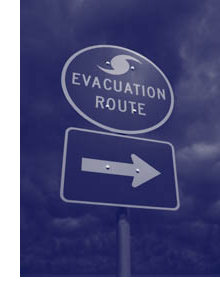CONCLUSION

This Primer presents guidance that will assist transportation officials and other stakeholders in preparing evacuation plans capable of addressing little- and no-notice incidents. It is designed to present information and pose questions that will help transportation professionals identify and address many of the issues relevant to preparing for a no-notice evacuation. It highlights critical operational and logistical issues and is meant to stimulate discussion that will pinpoint concrete decisions relevant to evacuation preparation and response. By using this Primer to supplement their normal plan development process, agencies should be able to develop evacuation plans that are actionable and better able to effectively respond to the types of challenges that arise in a no-notice scenario.
The information presented in this Primer is intended to be one resource in a larger planning process. Transportation agencies should use the Primer to gain a better understanding of what is involved in a little- or no-notice evacuation, and how best to prepare for it. To gain a good overall understanding of evacuation planning, transportation professionals should refer to the other primers in this series, as well as the numerous documents and Web sites identified throughout the Primer. These will present a comprehensive view of all aspects of evacuation preparedness, including planning, command and control, strategies and tactics, and special considerations for vulnerable populations and other special needs groups.
This knowledge can be leveraged to achieve more meaningful participation in planning efforts conducted with other stakeholders. By bringing attention to transportation-specific issues involved in an evacuation, in terms of both the challenges facing the transportation network as well as the resources that can used, transportation agencies can advocate at the State, regional, and local levels for the proper roles and responsibilities during an evacuation.
Transportation agencies should also consider the roles and responsibilities of their staffs and equipment when planning for and responding to evacuations. In particular, transportation professionals offer the expertise and operational control of specialized information systems used primarily for congestion management purposes that can further the regional coordination and response of emergency management agencies and first responders. The capital investments in ITS architectures and technology deployments provide an information-based infrastructure that can be used to enhance situational awareness and communication capabilities in real time. Information about these systems can be found in the first Primer of this series.

FHWA Office of Operations, HOTO
1200 New Jersey Avenue, SE
Washington, DC 20590
FHWA-HOP-08-003
November 2007